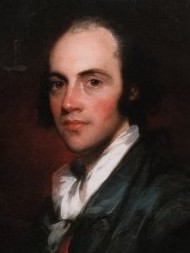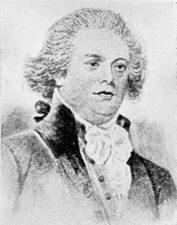| |||||||||||||||||
| |||||||||||||||||
| |||||||||||||||||
The 1795 United States Senate election in New York was held on January 27, 1795 by the New York State Legislature to elect a U.S. Senator (Class 3) to represent the State of New York in the United States Senate.
| |||||||||||||||||
| |||||||||||||||||
| |||||||||||||||||
The 1795 United States Senate election in New York was held on January 27, 1795 by the New York State Legislature to elect a U.S. Senator (Class 3) to represent the State of New York in the United States Senate.
In July 1789, Philip Schuyler and Rufus King had been elected to the U.S. Senate. King had drawn the long term which would expire on March 3, 1795.
At the State election in April 1794, Federalist majorities were elected to both houses of the 18th New York State Legislature which met from January 6 to 14 at Poughkeepsie, New York, and from January 20 to April 9, 1795, at New York City.
King's name was proposed for re-election in the Senate, and passed narrowly with 12 Yeas and 11 Nays. [1]
In the Assembly, two alternatives were proposed: State Senator Thomas Tillotson and Judge John Lawrence. [1]
| Party | Candidate | Votes | % | |
|---|---|---|---|---|
| Federalist | Rufus King | 35 | 53.03% | |
| Federalist | Thomas Tillotson | 30 | 45.45% | |
| Federalist | John Lawrence [lower-alpha 1] | 1 | 1.52% | |
| Total votes | 66 | 100.00% | ||
Rufus King was appointed U.S. Minister to Great Britain, and resigned from the U.S. Senate on May 23, 1796. A special election to fill the vacancy was held in November 1796.

The 1789 United States Senate election in New York was held in July 1789 to elect two U.S. Senators to represent the State of New York in the United States Senate. It was the first such election, and before the actual election the New York State Legislature had to establish the proceedings how to elect the senators.

The 1791 United States Senate election in New York was held on January 19, 1791, by the New York State Legislature to elect a U.S. Senator to represent the State of New York in the United States Senate. The election was conducted by a system of approval voting.

The 1796 United States Senate special election in New York was held on November 9, 1796, by the New York State Legislature to elect a U.S. Senator to represent the State of New York in the United States Senate.

The 1797 United States Senate election in New York was held on January 24, 1797, by the New York State Legislature to elect a U.S. Senator to represent the State of New York in the United States Senate. Incumbent Senator Aaron Burr's name was not placed into nomination for a second term. Former Senator Philip Schuyler was elected.
The second 1800 United States Senate special election in New York was held on November 6, 1800, by the New York State Legislature to elect a U.S. Senator to represent the State of New York in the United States Senate.
The 1802 United States Senate special election in New York was held on February 9, 1802, by the New York State Legislature to elect a U.S. Senator to represent the State of New York in the United States Senate.
The second 1804 United States Senate special election in New York was held on November 9, 1804, by the New York State Legislature to elect a U.S. Senator to represent the State of New York in the United States Senate.

The 1813 United States Senate election in New York was held on February 2, 1813, by the New York State Legislature to elect a U.S. Senator to represent the State of New York in the United States Senate.

The 1819/1820 United States Senate election in New York was held on February 2, 1819, and January 8, 1820, by the New York State Legislature to elect a U.S. Senator to represent the State of New York in the United States Senate.

The 1825/1826 United States Senate election in New York was held on February 1, 1825, and January 14, 1826, by the New York State Legislature to elect a U.S. Senator to represent the State of New York in the United States Senate.

The 1863 United States Senate election in New York was held on February 3, 1863, by the New York State Legislature to elect a U.S. Senator to represent the State of New York in the United States Senate.
The 1790 and 1791 United States Senate elections were the second series of elections of senators in the United States. In these elections, terms were up for the nine senators in Class 1. As of these elections, formal organized political parties had yet to form in the United States, but two political factions were present: The coalition of senators who supported President George Washington's administration were known as the Pro-Administration Party, and the senators against him as the Anti-Administration Party.
The 1856 and 1857 United States Senate elections were elections which had the young Republican Party assume its position as one of the United States's two main political parties. The Whigs and Free Soilers were gone by the time the next Congress began.
The 1794 and 1795 United States Senate elections were elections that had the formation of organized political parties in the United States, with the Federalist Party emerging from the Pro Administration coalition, and the Democratic-Republican Party emerging from the Anti-Administration coalition.

The 1788 and 1789 United States Senate elections were the first elections for the United States Senate, which coincided with the election of President George Washington. As of this election, formal organized political parties had yet to form in the United States, but two political factions were present: The coalition of senators who supported George Washington's administration were known as "Pro-Administration", and the senators against him as "Anti-Administration".

The 13th New York State Legislature, consisting of the New York State Senate and the New York State Assembly, met from July 6, 1789, to April 6, 1790, during the thirteenth year of George Clinton's governorship, first in Albany, then in New York City.

The 14th New York State Legislature, consisting of the New York State Senate and the New York State Assembly, met from January 5 to March 24, 1791, during the fourteenth year of George Clinton's governorship, in New York City.

The 18th New York State Legislature, consisting of the New York State Senate and the New York State Assembly, met from January 6 to April 9, 1795, during the eighteenth year of George Clinton's governorship, first in Poughkeepsie, then in New York City.

The 19th New York State Legislature, consisting of the New York State Senate and the New York State Assembly, met from January 6 to April 11, 1796, during the first year of John Jay's governorship, in New York City.

The 20th New York State Legislature, consisting of the New York State Senate and the New York State Assembly, met from November 1, 1796, to April 3, 1797, during the second year of John Jay's governorship, first in New York City, then in Albany.